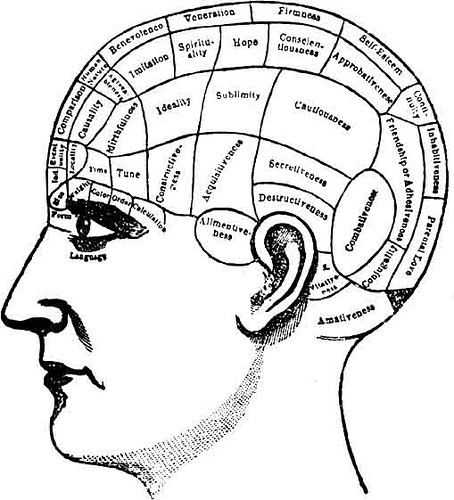Week 7 - Jayden Perry
Neuroscience + Art
The study of our brains and the idea of what consciousness and unconsciousness is is relatively new. However, even though it is a new idea that we are exploring, it is fascinating to learn the discoveries that have been made through neuroscience and art. Because its research is expanding so quickly, we have to consider if machines are expansing our consciousness or if we are becoming slaves to machines for research purposes (Vesna 0:20).
The first studies of the brain originated from Franz Joseph Gall and his practice of phrenology which structured the brain in sections based on feeling bumps on an individuals head (Vesna 3:51). Through further research, Gall discovered that the brain is filled with neurons and nerve cells that function by telling an individual what to do and how to feel. Understanding the nervous system has helped us explain how we relate aggressive and criminal behavior to dysfunction firing in the pre-frontal cortex, depression and sadness is seen as a serotonin imbalance, and the release of endorphins relate to the sensation of pleasure (Frazzetto). In addition to explaining what happens in our brains, we can also understand that our brains are capable of working in tandem with others (Albu). Mark S. Cohen and Victoria Vesna demonstrated this in the Octopus Brainstorming which showed brain-to-brain communication between two people through the colors that lit up on octopus crowns. This just goes on to explain how powerful our brains truly are.
Lecture 1 and the information of the Brainbow really influenced my understanding of neuroscience and art. The Brainbow was a method used to distinguish different neurons through the use of color and art. Though this technique we can easily see how our brains are highly complex and interrelated with our actions, feelings, and emotions. Even though we tend to think that we feel or act a certain way just because, there is much more going on in our brains which result in us behaving and feeling the ways we do.
Resources
Albu, Cristina. “Planetary Re-Enchantment: Human-Animal Entanglements in Victoria Vesna’s Octopus Brainstorming.” CMA Journal - Simon Fraser University, www.sfu.ca/cmajournal/issues/issue-ten--enchantment--disenchantment--reenchantment/cristina-albu.html?fbclid=IwAR1twyrqbeKqNrJSUXSihLVGvX_D9ARndxDv3USnw2pTENE_iXHJtIo8v54. Accessed 18 May 2023.
Frazzetto, Giovanni, and Suzanne Anker. “Neuroculture.” Nature Reviews Neuroscience, vol. 10, no. 11, 2009, pp. 815–821, https://doi.org/10.1038/nrn2736.
Purtill, James. Do Dreams Reflect Reality? Scientists Created an AI to Find Out, ABC, 6 Sept. 2020, https://encrypted-tbn0.gstatic.com/images?q=tbn:ANd9GcR4_bVvmqGym160GF8p6TPbS8pfWDb-gGn9ekMJMfbaZqHNhc7EHIv8dfW3yhr771Fa9FzYKbnUAXQ&usqp=CAU&ec=48665701. Accessed 18 May 2023.
Rhoads, Dan. “Fluorescent Neurons Over the Brainbow .” BiteSize Bio, 2 Nov. 2007, https://bitesizebio.com/wp-content/uploads/2007/11/livet.png. Accessed 18 May 2023.
Suni, Eric. “Dreams: Why We Dream & How They Affect Sleep.” Sleep Foundation, 23 Mar. 2023, www.sleepfoundation.org/dreams#:~:text=Dreams%20are%20images%2C%20thoughts%2C%20or,dream%20in%20black%20and%20white.
Vesna, Victoria. “Lecture 1: Consciousness / Memory”.
Vesna, Victoria. “Lecture 2: Unconscious Mind / Dreams”.
Vesna, Victoria. “Mind Intro” YouTube, 26 Mar. 2012, https://www.youtube.com/watch?v=RF0Qt7L2-kM.
Waltsak, Paul. “Physiognomic/Phrenologic Head.” The History of Neuroscience , 12 Dec. 2012, https://farm9.staticflickr.com/8483/8235476095_67da3699a6.jpg. Accessed 18 May 2023.


Hi Jayden, thank you for taking the time to write a really insightful blog post. The concept of the Brainbow was something that also caught my attention and allowed me to fully visualize the intersection between art and neuroscience. It is so fascinating to see how art can be applied in order to make scientific concepts for accessible and easy to understand and process. I really appreciate all the folk who actively attempt to use visual mediums in an effort to make learning more accessible and easy to conceptualize. The entanglement of art and science is truly revolutionary.
ReplyDelete